2008 MERCEDES-BENZ E-CLASS ESTATE width
[x] Cancel search: widthPage 155 of 401
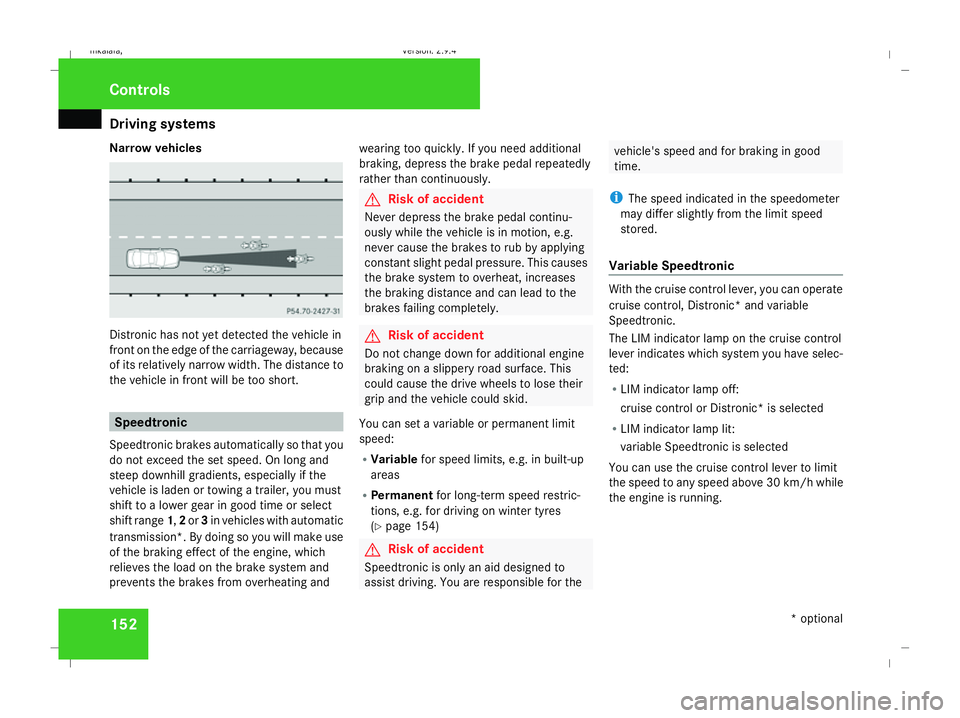
Driving sys
tems 152
Narrow vehicles
Distronic has not yet detected the vehicle in
front on the edge of the carriageway, because
of its relatively narrow width. The distance to
the vehicle in front will be too short. Speedtronic
Speedtronic brakes automatically so that you
do not exceed the set speed. On long and
steep downhill gradients, especially if the
vehicle is laden or towing a trailer, you must
shift to a lower gear in good time or select
shift range 1,2or 3in vehicles with automatic
transmission*. By doing so you will make use
of the braking effect of the engine, which
relieves the load on the brake system and
prevents the brakes from overheating and wearing too quickly. If you need additional
braking, depress the brake pedal repeatedly
rather than continuously. G
Risk of accident
Never depress the brake pedal continu-
ously while the vehicle is in motion, e.g.
never cause the brakes to rub by applying
constant slight pedal pressure. This causes
the brake system to overheat, increases
the braking distance and can lead to the
brakes failing completely. G
Risk of accident
Do not change down for additional engine
braking on a slippery road surface. This
could cause the drive wheels to lose their
grip and the vehicle could skid.
You can set a variable or permanent limit
speed:
R Variable for speed limits, e.g. in built-up
areas
R Permanent for long-term speed restric-
tions, e.g. for driving on winter tyres
(Y page 154) G
Risk of accident
Speedtronic is only an aid designed to
assist driving. You are responsible for the vehicle's speed and for braking in good
time.
i The speed indicated in the speedometer
may differ slightly from the limit speed
stored.
Variable Speedtronic With the cruise control lever, you can operate
cruise control, Distronic* and variable
Speedtronic.
The LIM indicator lamp on the cruise control
lever indicates which system you have selec-
ted:
R LIM indicator lamp off:
cruise control or Distronic* is selected
R LIM indicator lamp lit:
variable Speedtronic is selected
You can use the cruise control lever to limit
the speed to any speed above 30 km/ hwhile
the engine is running. Controls
* optional
211_AKB; 2; 5, en-GB
mkalafa,
Version: 2.9.4 2008-02-29T16:57:07+01:00 - Seite 152Dateiname: 6515_3416_02_buchblock.pdf; preflight
Page 231 of 401
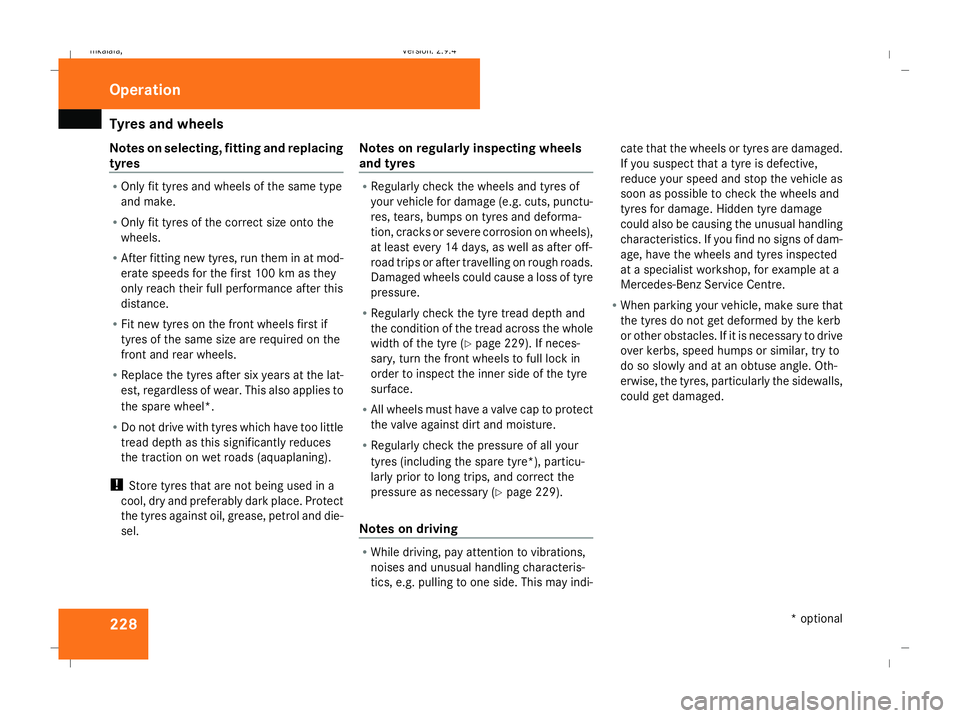
Tyres and wheels
228
Notes on selecting, fitting and replacing
tyres R
Only fit tyres and wheels of the same type
and make.
R Only fit tyres of the correct size onto the
wheels.
R After fitting new tyres, run them in at mod-
erate speeds for the first 100 km as they
only reach their full performance after this
distance.
R Fit new tyres on the front wheels first if
tyres of the same size are required on the
front and rear wheels.
R Replace the tyres after six years at the lat-
est, regardless of wear. This also applies to
the spare wheel*.
R Do not drive with tyres which have too little
tread depth as this significantly reduces
the traction on wet roads (aquaplaning).
! Store tyres that are not being used in a
cool, dry and preferably dark place. Protect
the tyres against oil, grease, petrol and die-
sel. Notes on regularly inspecting wheels
and tyres R
Regularly check the wheels and tyres of
your vehicle for damage (e.g. cuts, punctu-
res, tears, bumps on tyres and deforma-
tion, cracks or severe corrosion on wheels),
at least every 14 days, as well as after off-
road trips or after travelling on rough roads.
Damaged wheels could cause a loss of tyre
pressure.
R Regularly check the tyre tread depth and
the condition of the tread across the whole
width of the tyre (Y page 229). If neces-
sary, turn the front wheels to full lock in
order to inspect the inner side of the tyre
surface.
R All wheels must have a valve cap to protect
the valve against dirt and moisture.
R Regularly check the pressure of all your
tyres (including the spare tyre*), particu-
larly prior to long trips, and correct the
pressure as necessary (Y page 229).
Notes on driving R
While driving, pay attention to vibrations,
noises and unusual handling characteris-
tics, e.g. pulling to one side. This may indi- cate that the wheels or tyres are damaged.
If you suspect that a tyre is defective,
reduce your speed and stop the vehicle as
soon as possible to check the wheels and
tyres for damage. Hidden tyre damage
could also be causing the unusual handling
characteristics. If you find no signs of dam-
age, have the wheels and tyres inspected
at a specialist workshop, for example at a
Mercedes-Benz Service Centre.
R When parking your vehicle, make sure that
the tyres do not get deformed by the kerb
or other obstacles. If it is necessary to drive
over kerbs, speed humps or similar, try to
do so slowly and at an obtuse angle. Oth-
erwise, the tyres, particularly the sidewalls,
could get damaged. Operation
* optional
211_AKB; 2; 5, en-GB
mkalafa
,V ersion: 2.9.4
2008-02-29T16:57:07+01:00 - Seite 228 Dateiname: 6515_3416_02_buchblock.pdf; preflight
Page 232 of 401
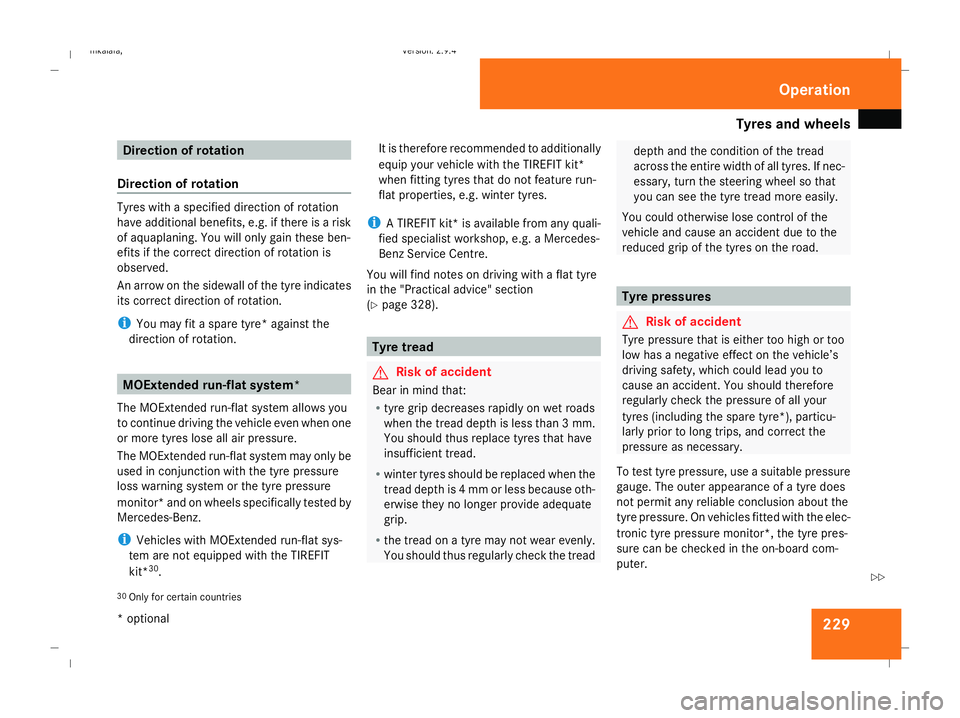
Tyres and wheels
229Direction of rotation
Direction of rotation Tyres with a specified direction of rotation
have additional benefits, e.g. if there is a risk
of aquaplaning. You will only gain these ben-
efits if the correct direction of rotation is
observed.
An arrow on the sidewall of the tyre indicates
its correct direction of rotation.
i You may fit a spare tyre* against the
direction of rotation. MOExtended run-flat system*
The MOExtended run-flat system allows you
to continue driving the vehicle even when one
or more tyres lose all air pressure.
The MOExtended run-flat system may only be
used in conjunction with the tyre pressure
loss warning system or the tyre pressure
monitor* and on wheels specifically tested by
Mercedes-Benz.
i Vehicles with MOExtended run-flat sys-
tem are not equipped with the TIREFIT
kit* 30
. It is therefore recommended to additionally
equip your vehicle with the TIREFIT kit*
when fitting tyres that do not feature run-
flat properties, e.g. winter tyres.
i A TIREFIT kit* is available from any quali-
fied specialist workshop, e.g. a Mercedes-
Benz Service Centre.
You will find notes on driving with a flat tyre
in the "Practical advice" section
(Y page 328). Tyre tread
G
Risk of accident
Bear in mind that:
R tyre grip decreases rapidly on wet roads
when the tread depth is less than 3 mm.
You should thus replace tyres that have
insufficient tread.
R winter tyres should be replaced when the
tread depth is 4 mm or less because oth-
erwise they no longer provide adequate
grip.
R the tread on a tyre may not wear evenly.
You should thus regularly check the tread depth and the condition of the tread
across the entire width of all tyres. If nec-
essary, turn the steering wheel so that
you can see the tyre tread more easily.
You could otherwise lose control of the
vehicle and cause an accident due to the
reduced grip of the tyres on the road. Tyre pressures
G
Risk of accident
Tyre pressure that is either too high or too
low has a negative effect on the vehicle’s
driving safety, which could lead you to
cause an accident. You should therefore
regularly check the pressure of all your
tyres (including the spare tyre*), particu-
larly prior to long trips, and correct the
pressure as necessary.
To test tyre pressure, use a suitable pressure
gauge. The outer appearance of a tyre does
not permit any reliable conclusion about the
tyre pressure. On vehicles fitted with the elec-
tronic tyre pressure monitor*, the tyre pres-
sure can be checked in the on-board com-
puter.
30 Only for certain countries Operation
* optional
211_AKB; 2; 5, en-GB
mkalafa
,V ersion: 2.9.4
2008-02-29T16:57:07+01:00 - Seite 229 ZDateiname: 6515_3416_02_buchblock.pdf; preflight
Page 369 of 401
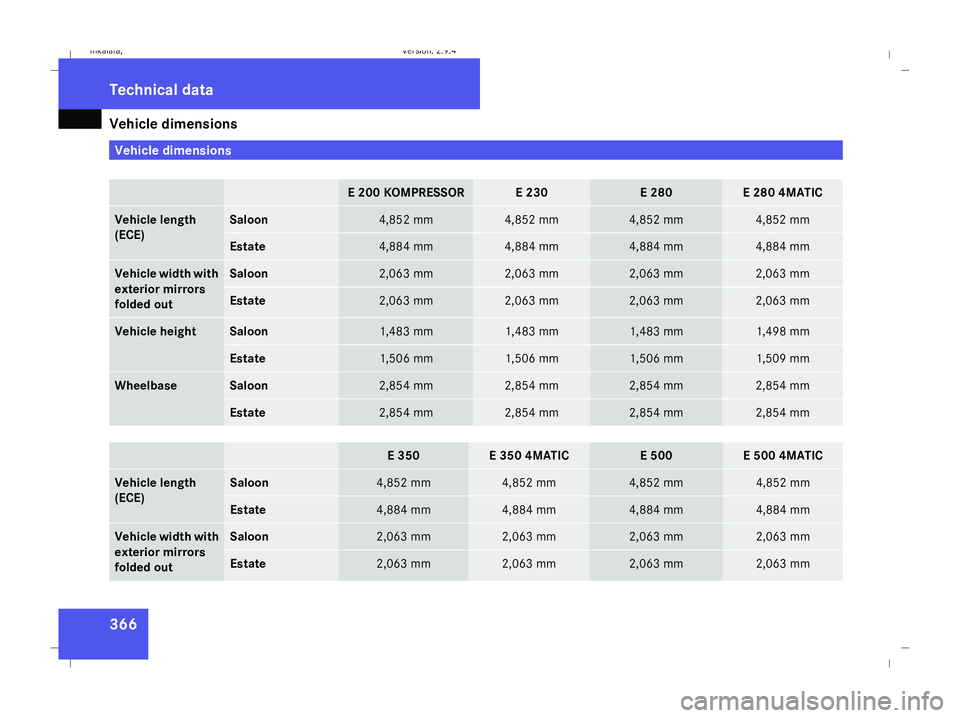
Vehicle dimensions
366 Vehicle dimensions
E 200 KOMPRESSOR E 230 E 280 E 280 4MATIC
Vehicle length
(ECE) Saloon 4,852 mm 4,852 mm 4,852 mm 4,852 mm
Estate 4,884 mm 4,884 mm 4,884 mm 4,884 mm
Vehicle width with
exterior mirrors
folded out Saloon 2,063 mm 2,063 mm 2,063 mm 2,063 mm
Estate 2,063 mm 2,063 mm 2,063 mm 2,063 mm
Vehicle height Saloon 1,483 mm 1,483 mm 1,483 mm 1,498 mm
Estate 1,506 mm 1,506 mm 1,506 mm 1,509 mm
Wheelbase Saloon 2,854 mm 2,854 mm 2,854 mm 2,854 mm
Estate 2,854 mm 2,854 mm 2,854 mm 2,854 mm
E 350 E 350 4MATIC E 500 E 500 4MATIC
Vehicle length
(ECE) Saloon 4,852 mm 4,852 mm 4,852 mm 4,852 mm
Estate 4,884 mm 4,884 mm 4,884 mm 4,884 mm
Vehicle width with
exterior mirrors
folded out Saloon 2,063 mm 2,063 mm 2,063 mm 2,063 mm
Estate 2,063 mm 2,063 mm 2,063 mm 2,063 mmTechnical data
211_AKB; 2; 5, en-GB
mkalafa,
Version: 2.9.4 2008-02-29T16:57:07+01:00 - Seite 366Dateiname: 6515_3416_02_buchblock.pdf; preflight
Page 370 of 401
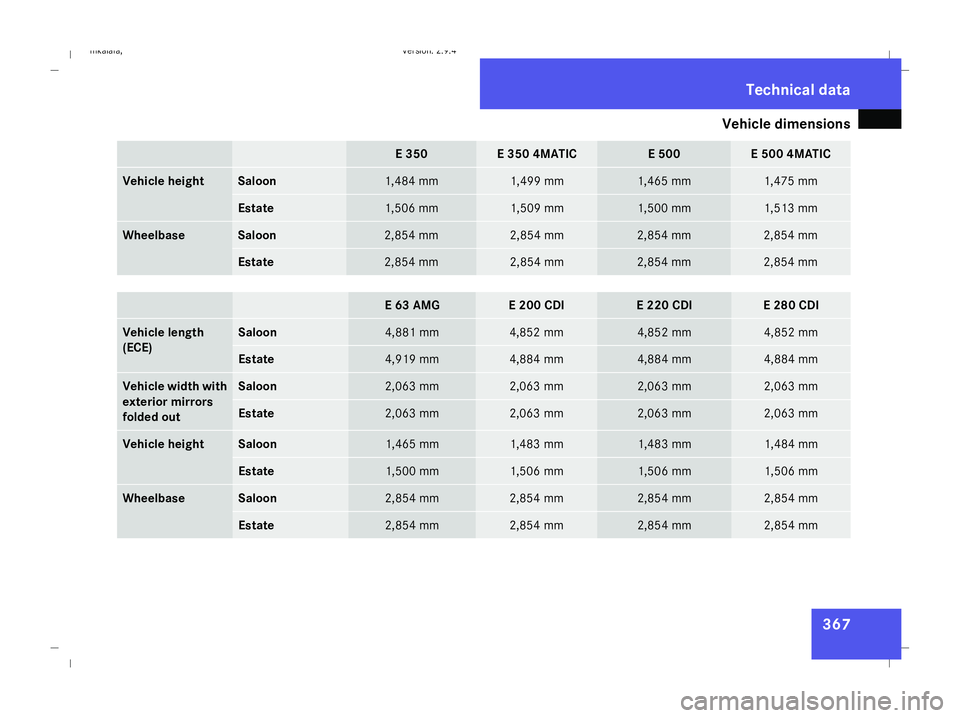
Vehicle dimensions
367E 350 E 350 4MATIC E 500 E 500 4MATIC
Vehicle height Saloon 1,484 mm 1,499 mm 1,465 mm 1,475 mm
Estate 1,506 mm 1,509 mm 1,500 mm 1,513 mm
Wheelbase Saloon 2,854 mm 2,854 mm 2,854 mm 2,854 mm
Estate 2,854 mm 2,854 mm 2,854 mm 2,854 mm
E 63 AMG E 200 CDI E 220 CDI E 280 CDI
Vehicle length
(ECE) Saloon 4,881 mm 4,852 mm 4,852 mm 4,852 mm
Estate 4,919 mm 4,884 mm 4,884 mm 4,884 mm
Vehicle width with
exterior mirrors
folded out Saloon 2,063 mm 2,063 mm 2,063 mm 2,063 mm
Estate 2,063 mm 2,063 mm 2,063 mm 2,063 mm
Vehicle height Saloon 1,465 mm 1,483 mm 1,483 mm 1,484 mm
Estate 1,500 mm 1,506 mm 1,506 mm 1,506 mm
Wheelbase Saloon 2,854 mm 2,854 mm 2,854 mm 2,854 mm
Estate 2,854 mm 2,854 mm 2,854 mm 2,854 mmTechnical data
211_AKB; 2; 5, en-GB
mkalafa,
Version: 2.9.4
2008-02-29T16:57:07+01:00 - Seite 367 ZDateiname: 6515_3416_02_buchblock.pdf; preflight
Page 371 of 401
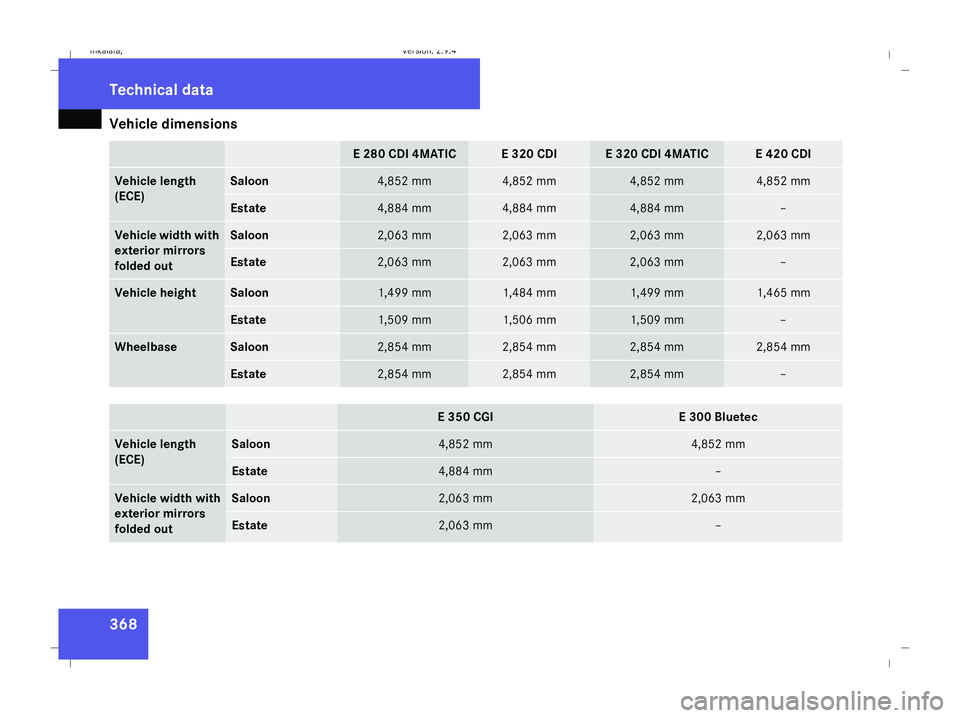
Vehicle dimensions
368 E 280 CDI 4MATIC E 320 CDI E 320 CDI 4MATIC E 420 CDI
Vehicle length
(ECE) Saloon 4,852 mm 4,852 mm 4,852 mm 4,852 mm
Estate 4,884 mm 4,884 mm 4,884 mm –
Vehicle width with
exterior mirrors
folded out Saloon 2,063 mm 2,063 mm 2,063 mm 2,063 mm
Estate 2,063 mm 2,063 mm 2,063 mm –
Vehicle height Saloon 1,499 mm 1,484 mm 1,499 mm 1,465 mm
Estate 1,509 mm 1,506 mm 1,509 mm –
Wheelbase Saloon 2,854 mm 2,854 mm 2,854 mm 2,854 mm
Estate 2,854 mm 2,854 mm 2,854 mm –
E 350 CGI E 300 Bluetec
Vehicle length
(ECE) Saloon 4,852 mm 4,852 mm
Estate 4,884 mm –
Vehicle width with
exterior mirrors
folded out Saloon 2,063 mm 2,063 mm
Estate 2,063 mm –Technical data
211_AKB; 2; 5, en-GB
mkalafa,
Version: 2.9.4 2008-02-29T16:57:07+01:00 - Seite 368Dateiname: 6515_3416_02_buchblock.pdf; preflight